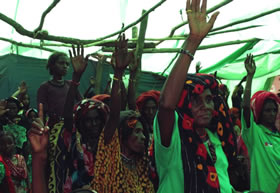UNFPA: Good Practice Example 1
UNFPA–UNICEF Joint Programme on Female Genital Mutilation/Cutting (FGM/C)
 |
| Public declaration of FGM/C abandonment in Afar region, Ethiopia. (Photo: UNFPA) |
The UNFPA-UNICEF Joint Programme on Accelerating the Abandonment of Female Genital Mutilation/Cutting (FGM/C) addresses the human rights of women and girls. FGM/C reflects deep-rooted inequalities between the sexes and constitutes an extreme form of discrimination against women and girls. FGM/C takes place in rural and urban settings, but is generally more challenging to address in rural areas where more conservative norms and social standards and small community size reinforce barriers to behaviour change. Nearly all of the 15 Joint Programme participating countries have adopted policies, laws or constitutional provisions aimed at protecting the rights of women and girls. With respect specifically to FGM/C, there is increased awareness about the harmful health effects of FGM/C and its violation of women's and girls' rights, which is leading to increased disapproval of the practice among women and men. Moreover, a reduction of prevalence (up to 16% of decrease) is being seen in some countries where the Demographic and Health Survey (DHS) and the Multiple Indicator Cluster Survey (MICS) data is available. Linked to the discussion of FGM/C other issues, such as family size, child marriage, women's inheritance rights, reproductive rights and reproductive health services are now being discussed publicly in village churches, mosques and temples.
The Joint Programme was initiated in 2008. It has since facilitated work on the abandonment of FGM/C in 15 countries in Africa and the Arab states, by scaling up methodologies similar to the model developed by Tostan, a Senegalese civil society organization that started working on the abandonment of FGM/C in 1997. Based on the programme's good practice and demonstrated results, additional countries are adapting the model to their specific social, ethnic and cultural context to promote the abandonment of FGM/C.
There are a number of integrated interventions that have contributed to the growing success of the programme, including:
- Enabling community leaders, Community Services Organizations (CSOs) and Non Governmental Organizations (NGOs) to take the lead in advocating for the end of the practice.
- Working with religious leaders to discredit the belief that FGM/C is a religious obligation.
- ensuring an enabling national environment for promoting abandonment of the practice;
- enabling communities to discuss and reaffirm the positive values that are shared within their culture, including wanting to do the best for their girls, and connecting them to human rights;
- engaging all groups within a community in the discussion, including traditional and religious leaders, young girls themselves, women and men;
- ensuring discussion of the harms of the practice and that it is not a religious requirement, with information coming from trusted sources;
- facilitating public manifestations of the commitment to abandon the practice, thereby enabling others to see that others share the commitment;
- supporting the efforts of communities, including by informing of legislation and policies against the practice, which gives additional legitimacy to those committed to ending the practice.
- Linking and encouraging collaboration between FGM/C abandonment movements and community initiatives that address reproductive health of women and girls.
- Finding innovative solutions, such as the use of mobile vans, to reach families living in remote areas.
For further information, visit http://www.unfpa.org/gender/practices1.htm